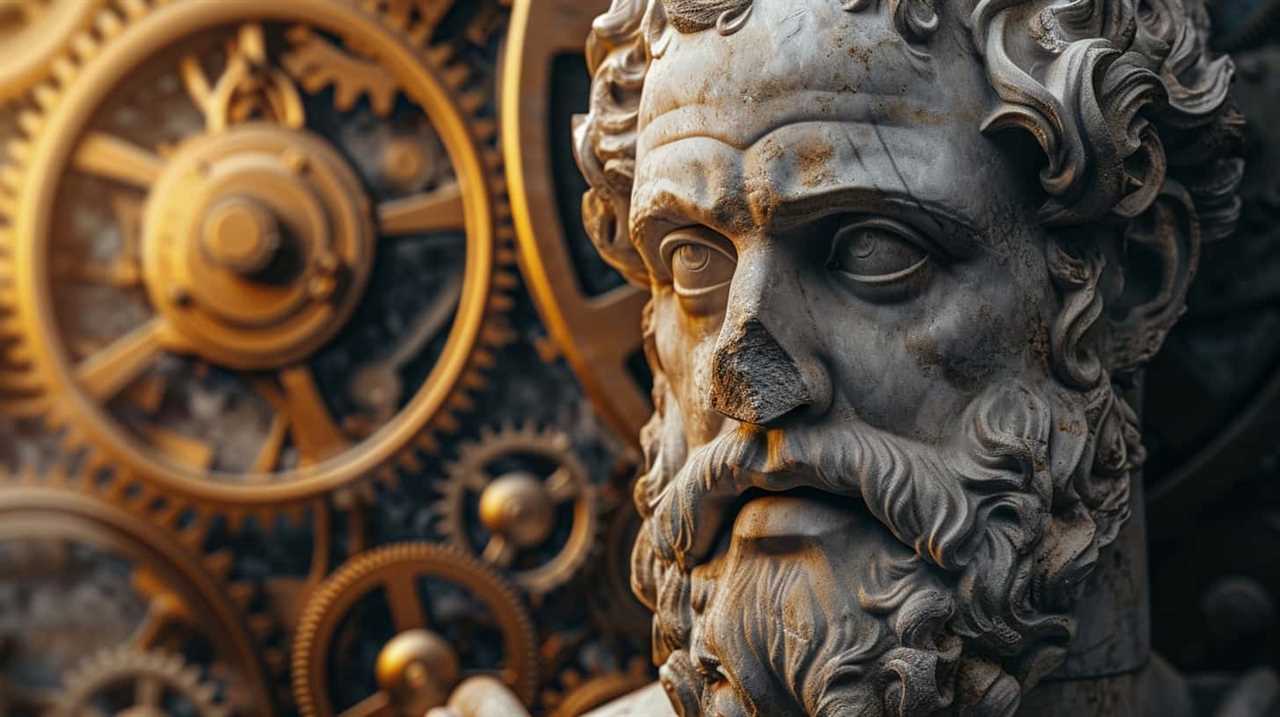Do you realize that Immanuel Kant, a significant philosopher of the 18th century, had extensive thoughts on the aesthetic judgment of art?
In this brief exploration, we will delve into Kant’s ideas and uncover the fascinating insights he offered on this subject.
Kant believed that aesthetic judgment, the ability to appreciate and evaluate art, played a crucial role in our understanding of beauty and our connection to the world around us.
He emphasized the importance of subjective experience and the concept of disinterestedness in art appreciation.
By examining Kant’s perspective, we can gain a deeper understanding of how art’s aesthetic judgment impacts our lives and the significance it holds in the realm of creativity and human expression.
Key Takeaways
- Kant believed in universal principles governing judgments of beauty in art
- Aesthetic judgments of art are based on the free play of cognitive faculties
- Harmony and unity are essential for an object to be considered beautiful in art
- Beauty in art enhances cognitive and moral development

Kant’s View on Aesthetic Judgment
In this article, we’ll explore Kant’s view on aesthetic judgment. When it comes to understanding subjectivity in aesthetic judgment, Kant argued that beauty isn’t simply a matter of personal taste or preference. Instead, he believed that there are universal principles and criteria that govern our judgments of beauty. According to Kant, aesthetic judgments are based on the free play of our cognitive faculties, specifically our imagination and understanding. This free play allows us to perceive the harmony and unity of an object, which is essential for it to be considered beautiful.
Kant also emphasized the role of beauty in our cognitive and moral development. He believed that experiencing beauty can enhance our capacity for understanding and moral reasoning. Through the contemplation of beautiful objects, we engage in a reflective and disinterested mode of thinking, which helps us cultivate our cognitive faculties. Additionally, Kant argued that the experience of beauty can evoke a sense of pleasure that’s distinct from mere sensory gratification. This pleasure isn’t tied to any particular desire or interest, but rather arises from the intrinsic qualities of the object itself.
Understanding art’s aesthetic quality is therefore crucial in Kant’s philosophy. He believed that art has the potential to communicate and express universal truths and ideas through its aesthetic form. Artistic creations, according to Kant, aren’t just beautiful objects to be admired, but also vehicles for the communication of profound and meaningful messages. By appreciating the aesthetic qualities of art, we can delve deeper into its underlying concepts and engage in a more profound understanding of the human experience.
In the subsequent section, we’ll further explore Kant’s ideas on understanding art’s aesthetic quality and its relation to the concept of genius.

Understanding Art’s Aesthetic Quality
Exploring art’s aesthetic quality allows us to delve into the subjective experience and universal principles that govern our judgments of beauty, according to Kant. When we engage with art, our interpretation of its aesthetic quality is inherently subjective. Each individual brings their own unique perspective, emotions, and personal history to the artwork, influencing how they perceive and appreciate its beauty. This subjectivity in interpretation is an integral part of the aesthetic experience.
However, Kant also acknowledged that cultural influences play a significant role in shaping our judgments of art’s aesthetic quality. Our cultural background, beliefs, and societal norms can greatly impact how we perceive and evaluate art. These cultural influences can shape our understanding of what’s considered beautiful or aesthetically pleasing. For example, what may be considered beautiful in one culture mightn’t hold the same value in another.
Despite the subjectivity and cultural influences, Kant believed that there are universal principles that govern our judgments of art’s aesthetic quality. He argued that these principles are based on our ability to recognize and appreciate the formal qualities of the artwork, such as harmony, proportion, and unity. These universal principles transcend personal preferences and cultural biases, providing a foundation for our aesthetic judgments.
Understanding art’s aesthetic quality requires us to navigate between the subjective and the universal. It involves recognizing the subjective nature of our interpretations while also acknowledging the influence of cultural factors. By doing so, we can gain a deeper appreciation for the diverse ways in which art can be perceived and understood, while also recognizing the underlying principles that contribute to our judgments of its aesthetic quality.

The Role of Subjectivity in Art Appreciation
When it comes to art appreciation, we can’t overlook the inherent subjectivity that arises from our personal experiences and perspectives. Our interpretation of art is shaped by the unique lens through which we view the world. This subjectivity in art interpretation is influenced by various factors, including cultural influences on art appreciation.
Subjectivity in art interpretation:
- Personal experiences: Our individual life experiences play a significant role in how we perceive and interpret art. Our upbringing, education, and personal beliefs all contribute to the lens through which we view and appreciate art. For example, someone who’s grown up in a religious household may interpret religious artwork differently than someone with no religious background.
- Emotional response: Art has the power to evoke strong emotions within us. The way we emotionally connect with a piece of art is subjective and varies from person to person. What may resonate deeply with one individual may leave another feeling indifferent. This emotional response is influenced by our unique perspectives and life experiences.
- Cultural context: Culture plays a crucial role in shaping our understanding and appreciation of art. Different cultures have varying artistic traditions, styles, and symbols. Our cultural background influences the meanings we assign to artworks and the significance we attribute to certain artistic elements. For example, a traditional Japanese painting may be appreciated differently by someone from Japan compared to someone from a Western culture.
Understanding the role of subjectivity in art appreciation allows us to appreciate the diversity of interpretations and perspectives that art can evoke. It reminds us that there’s no singular ‘correct’ way to appreciate art, but rather a multitude of valid interpretations. By embracing subjectivity, we can foster a more inclusive and enriching experience of art for ourselves and others.

The Concept of Disinterestedness in Aesthetic Judgment
Continuing our examination of subjectivity in art interpretation, we can now delve into the concept of disinterestedness in aesthetic judgment.
Disinterestedness, as defined by Immanuel Kant, refers to the ability to appreciate art for its own sake, without any personal desires or interests influencing our judgment. In the realm of aesthetic experience, this detachment allows us to focus solely on the artwork itself, its form, and its beauty, rather than any external factors or concerns.
According to Kant, disinterestedness is crucial for a genuine aesthetic judgment. When we approach a work of art with disinterestedness, we’re able to engage in a pure aesthetic experience, free from any ulterior motives or personal biases. This allows us to appreciate the artwork in its own right, as an object of beauty and artistic expression.
Disinterestedness in art is closely related to the idea of universality in aesthetic judgment. Kant argues that a true aesthetic judgment should be universally applicable, meaning that it should be possible for anyone to arrive at the same judgment, regardless of their personal tastes or preferences. Disinterestedness helps to ensure this universality, as it allows us to set aside our individual preferences and engage with the artwork on a purely aesthetic level.
However, achieving disinterestedness in art can be challenging. Our personal experiences, emotions, and cultural backgrounds often shape our interpretations and judgments. It requires a conscious effort to detach ourselves from these influences and approach the artwork with an open mind.

Beauty as a Key Criterion for Aesthetic Judgment
Beauty serves as a fundamental criterion for our aesthetic judgment, according to Immanuel Kant. However, it’s important to note that beauty’s subjectivity plays a significant role in shaping our aesthetic experience. Kant argues that beauty isn’t an objective property inherent in the artwork itself, but rather a subjective response that arises from the interaction between the artwork and the observer. This subjectivity implies that different individuals may perceive beauty differently, as their personal tastes, preferences, and cultural backgrounds influence their aesthetic judgments.
To further understand the role of beauty in aesthetic judgment, let’s consider the following points:
- Beauty as a Sensory Experience: Kant suggests that beauty is primarily a sensory experience that evokes pleasure and satisfaction. It’s through our senses that we apprehend the aesthetic qualities of an artwork, such as its form, color, texture, and harmony. These sensory qualities contribute to our overall perception of beauty and shape our aesthetic judgment.
- Beauty as a Reflection of Harmony: Kant argues that beauty is closely connected to the concept of harmony. He suggests that when we perceive an artwork as beautiful, we’re perceiving a harmonious arrangement of elements that appeals to our aesthetic sensibilities. This harmony can be found in the proportions, balance, and unity of the artwork, creating a sense of coherence and pleasing aesthetic experience.
- Beauty as a Source of Pleasure: For Kant, beauty isn’t merely a visual quality, but also a source of pleasure. He believes that when we perceive something as beautiful, we experience a disinterested pleasure, meaning that our pleasure isn’t contingent on any personal interest or desire. This disinterested pleasure allows us to appreciate the artwork solely for its aesthetic qualities, enhancing our aesthetic judgment.

The Significance of Universality in Art’s Aesthetic Value
To understand the significance of universality in art’s aesthetic value, we must explore Immanuel Kant’s perspective on the subject. According to Kant, aesthetic judgment involves a subjective appreciation of art that goes beyond personal preferences and individual tastes. It requires a disinterestedness in judgment, where one appreciates the beauty of the artwork for its own sake, rather than for any personal gain or interest. In this sense, the universality of art’s aesthetic value lies in its ability to be appreciated by all individuals, regardless of their personal inclinations.
Kant argues that fine art, as opposed to applied art, possesses a higher aesthetic value because it allows for a greater degree of subjective interpretation. Fine art isn’t constrained by practical considerations and allows for more freedom of expression, which contributes to its universality. Furthermore, Kant believes that the experience of beauty in art is closely tied to morality, as it cultivates a sense of pleasure that’s in harmony with our moral sensibilities.
Kant also emphasizes the role of genius in the production of art. The genius, according to him, possesses a unique combination of natural talent and artistic skill that enables them to create works of art that are universally appreciated. This artistic freedom allows geniuses to transcend the ordinary and connect their art to the sublime, evoking profound emotions and inspirations in the viewer.
Kant’s critique of taste and his emphasis on the universality of aesthetic judgment still hold relevance in contemporary art criticism. By recognizing the importance of disinterestedness in our judgment of art, we can appreciate the beauty and significance of artworks that may be outside our personal preferences. This opens up new possibilities for dialogue and appreciation, fostering a more inclusive and enriching artistic experience for all.

Kant’s Distinction Between Fine Art and Applied Art
Kant distinguishes between fine art and applied art based on their respective levels of subjective interpretation and practical considerations. From Kant’s perspective, fine art is primarily concerned with aesthetic judgment and the subjective experience of beauty. Applied art, on the other hand, serves practical purposes and is driven by considerations such as functionality and utility.
To differentiate between the two, Kant highlights three key aspects:
- Subjectivity of interpretation: Fine art allows for a greater degree of subjective interpretation. It invites individuals to engage in the contemplation and appreciation of beauty for its own sake. The aesthetic judgment of fine art isn’t determined by external factors or practical considerations, but rather by the individual’s own subjective experience.
- Emphasis on aesthetic value: Fine art places a greater emphasis on aesthetic value, where the artwork is appreciated for its inherent beauty and ability to evoke emotions. It isn’t tied to any specific purpose or function, but exists purely to provide aesthetic pleasure and elicit intellectual and emotional responses.
- Practical considerations: Applied art, in contrast, is driven by practical considerations. It serves a specific purpose or function, such as design, decoration, or utility. The aesthetic judgment of applied art is influenced by its ability to fulfill these practical needs, rather than solely by its aesthetic value.
Through this differentiation, Kant highlights the distinction between art that’s created purely for its aesthetic qualities and art that serves a practical purpose. While fine art is valued for its ability to evoke aesthetic pleasure and emotional responses, applied art is appreciated for its functionality and utility. By understanding this distinction, we can better appreciate the unique qualities and contributions of both forms of art.

Art’s Relation to Pleasure and Morality
Moving beyond the distinction between fine art and applied art, we now delve into the relationship between art, pleasure, and morality. When considering art, we often associate it with pleasure, as it has the power to evoke emotions and provide aesthetic enjoyment. However, Immanuel Kant’s perspective on art challenges this notion by highlighting the ethical implications of aesthetic judgment.
For Kant, the pleasure derived from art is distinct from moral judgment. He argues that aesthetic pleasure is grounded in the free play of imagination and understanding, where we engage with art solely for its own sake. This pleasure is subjective and individual, varying from person to person. On the other hand, moral judgment is based on objective principles and universal laws, aiming to guide our actions towards moral duty.
However, Kant acknowledges that art can have a moral dimension. While the pleasure we derive from art isn’t directly linked to morality, he suggests that art can indirectly contribute to moral development. Art can serve as a vehicle for moral ideas and emotions, prompting us to reflect on our own moral values and actions. It can challenge our preconceived notions, provoke critical thinking, and inspire empathetic responses, all of which have ethical implications.
In this sense, art has the potential to enhance our moral sensibilities, but it doesn’t determine our moral judgments. The relationship between pleasure and morality in art is complex, as art can both challenge and reinforce existing moral frameworks. It’s up to the individual viewer to discern the ethical implications of art and apply them to their own lives.

The Role of Genius in Creating Artistic Beauty
Artistic beauty is often created by geniuses who consistently push the boundaries of creativity and innovation. These individuals have a unique role in shaping the artistic landscape, as they possess the ability to inspire and captivate audiences with their creations. The role of genius in creating artistic beauty can be examined from various perspectives, shedding light on the significance of inspiration and artistic creativity.
- Unleashing Inspiration: Geniuses have an innate ability to tap into a vast pool of inspiration. They possess a heightened sensitivity to their surroundings, allowing them to see beauty and potential where others may not. This capacity to connect with their environment and draw inspiration from it enables geniuses to create art that resonates deeply with viewers, evoking emotions and stirring the soul.
- Pushing Boundaries: Geniuses aren’t content with the status quo. They constantly seek to challenge existing norms and conventions, striving to break new ground and explore uncharted territories. By pushing the boundaries of artistic creativity, geniuses expand the realm of possibilities and inspire others to think outside the box. Their willingness to take risks and venture into unexplored realms of expression leads to the creation of groundbreaking art that revolutionizes the artistic landscape.
- Fostering Innovation: Geniuses are pioneers of innovation. They possess a unique ability to combine disparate elements and ideas, forging new connections and giving birth to novel artistic forms. Their innovative approach to artistic creation pushes the boundaries of what’s considered possible, inspiring others to think differently and embrace experimentation. Through their inventive spirit, geniuses pave the way for new artistic movements and styles, leaving an indelible mark on the course of artistic history.
The role of genius in creating artistic beauty can’t be underestimated. Through their ability to unleash inspiration, push boundaries, and foster innovation, geniuses shape the artistic landscape and leave a lasting legacy. Their contributions serve not only to entertain and delight audiences but also to challenge and inspire, enriching the human experience through the power of art.

The Concept of Artistic Freedom in Kant’s Aesthetics
In our exploration of Kant’s Aesthetics, we delve into the concept of artistic freedom and its significance. Kant’s perspective on artistic autonomy is an important aspect of his overall theory of aesthetic judgment.
According to Kant, artistic freedom allows the artist to express their individuality and creativity without being constrained by external rules or expectations. This freedom is essential for the artist to create works of art that are truly original and unique.
Artistic creativity plays a crucial role in aesthetic judgment, according to Kant. He argues that aesthetic judgment isn’t just about the subjective taste of the individual, but also involves the recognition of the artist’s skill and creativity. In other words, the artistic value of a work of art isn’t solely determined by the personal preferences of the viewer, but also by the artist’s ability to express their creative vision.
By emphasizing the importance of artistic freedom and creativity in aesthetic judgment, Kant highlights the unique role that artists play in the creation and appreciation of art. He believes that artists have a special ability to communicate their ideas and emotions through their work, and that this communication is a vital aspect of the aesthetic experience.
As we move forward in our exploration of Kant’s Aesthetics, we’ll now turn our attention to the connection between art’s aesthetic judgment and the sublime. The concept of the sublime is closely related to Kant’s theory of aesthetic judgment, as it involves the experience of awe and wonder that surpasses our ordinary understanding.

The Connection Between Art’s Aesthetic Judgment and the Sublime
The connection between art’s aesthetic judgment and the sublime lies in the experience of awe and wonder that surpasses our ordinary understanding. When we encounter a work of art that evokes the sublime, we’re confronted with something that transcends the limits of our imagination. It’s an experience that leaves us speechless, as we struggle to put into words the immense emotions that it stirs within us.
In exploring the connection between art’s aesthetic judgment and the sublime, we can consider the following:
- The role of nature in the sublime: Nature has long been associated with the sublime, as it possesses a power and grandeur that can overwhelm us. When art captures the sublime, it often draws upon the beauty and majesty of the natural world, allowing us to connect with something larger than ourselves.
- The emotional impact of the sublime on the viewer: The sublime has the ability to evoke intense emotions within us, such as awe, fear, and even a sense of insignificance. It challenges our understanding of the world and invites us to contemplate the mysteries of existence. Art that elicits the sublime can have a profound impact on our emotions, leaving us deeply moved and forever changed.
- The transformative nature of the sublime: The experience of the sublime can be transformative, as it expands our consciousness and opens us up to new perspectives. It invites us to question our preconceived notions and invites us to contemplate the vastness of the universe. Art that captures the sublime has the power to transport us beyond the confines of our everyday lives, offering us a glimpse into something greater.
The connection between art’s aesthetic judgment and the sublime is rooted in the ability of the sublime to elicit awe and wonder, and to provoke a profound emotional response in the viewer. It’s through this connection that art can transcend the ordinary and offer us a glimpse into the extraordinary.
As we delve deeper into Kant’s exploration of art’s aesthetic judgment, we must now turn our attention to his critique of taste and the problem of tastelessness.

Kant’s Critique of Taste and the Problem of Tastelessness
Moving from the connection between art’s aesthetic judgment and the sublime, we now delve into Kant’s critique of taste and the problem that arises with tastelessness. Taste, according to Kant, is a subjective judgment of beauty. It’s the ability to appreciate and evaluate something based on its aesthetic qualities. However, taste isn’t mere personal preference or opinion. Kant argues that there’s a universality to taste, and that there are objective criteria by which we can judge whether something is beautiful or not.
The problem of tastelessness arises when an individual lacks the ability to make a proper aesthetic judgment. This could be due to a lack of exposure to art, a failure to cultivate one’s aesthetic faculties, or an inability to appreciate the universal principles of beauty. Tastelessness can also manifest in the form of vulgar or kitschy art that appeals to base instincts rather than embodying the higher ideals of beauty.
Kant’s critique of taste serves as a reminder of the importance of cultivating our aesthetic faculties and engaging with art that embodies universal principles of beauty. By doing so, we’re able to make proper aesthetic judgments and appreciate the true value of art. In this way, taste becomes not just a matter of personal preference, but a means through which we can connect with others and attain a deeper understanding of the world around us.
In the subsequent section, we’ll explore the contemporary relevance of Kant’s ideas on art’s aesthetic judgment.

Contemporary Relevance of Kant’s Ideas on Art’s Aesthetic Judgment
With regards to the contemporary relevance of Kant’s ideas on art’s aesthetic judgment, we can draw upon his notion of universality and objective criteria to understand and evaluate the beauty of artwork today. Kant argued that aesthetic judgments should be based on a universal standard of taste, independent of personal preferences and cultural biases. This concept remains relevant in the context of contemporary art, where diverse artistic expressions and cultural backgrounds intersect. By applying Kant’s objective criteria, we can analyze and appreciate the relevance of contemporary art in a more nuanced and informed manner.
The impact of Kant’s ideas on art criticism today is significant. They’ve shaped the way we evaluate and interpret artworks, providing a framework that transcends subjective opinions. Kant’s emphasis on the universality of aesthetic judgments encourages us to consider the broader cultural, historical, and social contexts in which artworks exist. This approach allows for a more comprehensive understanding of contemporary art and its relevance to society.
Incorporating Kant’s ideas into art criticism also helps to establish a common language and criteria for evaluating contemporary art. By focusing on objective standards of beauty and artistic skill, we can move beyond personal preferences and subjective interpretations. This enables us to engage in more meaningful and constructive discussions about the value and impact of contemporary art.

Frequently Asked Questions
How Did Kant Define Aesthetic Judgment?
When discussing Kant’s view on aesthetic judgment, it is important to understand his definition of aesthetic judgment. According to Kant, aesthetic judgment is the subjective evaluation of beauty in an object or artwork.
What Is the Role of Subjectivity in Art Appreciation According to Kant?
Subjectivity plays a crucial role in art appreciation according to Kant. He argued that aesthetic judgments are based on personal subjective experiences and feelings, rather than objective criteria. This highlights the individual’s unique perspective and emotional response to art.
How Does Kant Explain the Concept of Disinterestedness in Aesthetic Judgment?
When considering the concept of disinterestedness in aesthetic judgment, Kant argues that it is essential for a truly authentic aesthetic experience. It requires us to detach ourselves from personal desires and preferences, allowing us to appreciate art objectively.
Does Kant Consider Beauty to Be the Most Important Criterion for Aesthetic Judgment?
Subjectivity in judgment is crucial in Kant’s theory of aesthetic judgment. While beauty is important, disinterestedness is even more significant as it allows for an unbiased evaluation of art’s aesthetic qualities.
How Does Kant Distinguish Between Fine Art and Applied Art?
In distinguishing between fine art and applied art, Kant’s perspective on art classification is based on the concept of aesthetic judgment. He emphasizes the importance of beauty and the autonomy of fine art, while functional art serves practical purposes.

Conclusion
In conclusion, Kant’s exploration of art’s aesthetic judgment reveals the intricate interplay between subjectivity and objectivity in our appreciation of art.
Through the concept of disinterestedness and the emphasis on beauty, Kant highlights the importance of our emotional and intellectual response to art.
His ideas on artistic freedom and the sublime continue to resonate in contemporary discussions on art.
However, Kant’s critique of taste also raises the question of tastelessness, reminding us of the complexities inherent in evaluating art.
Lauren’s talent in writing is matched by her passion for storytelling. Her love for books and deep understanding of culture and entertainment add a distinct flavor to her work. As our media and press contact, Lauren skillfully bridges the gap between afterQuotes and the broader media landscape, bringing our message to a wider audience.








